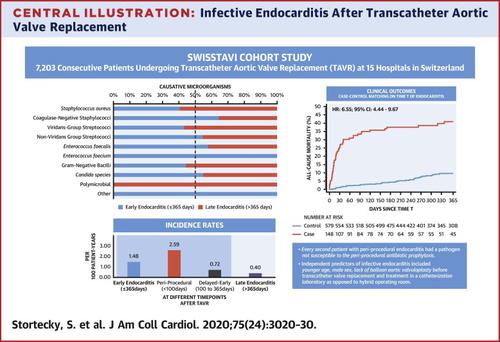当前位置:
X-MOL 学术
›
J. Am. Coll. Cardiol.
›
论文详情
Our official English website, www.x-mol.net, welcomes your
feedback! (Note: you will need to create a separate account there.)
Infective Endocarditis After Transcatheter Aortic Valve Replacement
Journal of the American College of Cardiology ( IF 21.7 ) Pub Date : 2020-06-01 , DOI: 10.1016/j.jacc.2020.04.044 Stefan Stortecky 1 , Dik Heg 2 , David Tueller 3 , Thomas Pilgrim 1 , Olivier Muller 4 , Stephane Noble 5 , Raban Jeger 6 , Stefan Toggweiler 7 , Enrico Ferrari 8 , Maurizio Taramasso 9 , Francesco Maisano 9 , Rebeca Hoeller 1 , Peter Wenaweser 10 , Fabian Nietlispach 11 , Andreas Widmer 12 , Christoph Huber 5 , Marco Roffi 5 , Thierry Carrel 1 , Stephan Windecker 1 , Anna Conen 13
Journal of the American College of Cardiology ( IF 21.7 ) Pub Date : 2020-06-01 , DOI: 10.1016/j.jacc.2020.04.044 Stefan Stortecky 1 , Dik Heg 2 , David Tueller 3 , Thomas Pilgrim 1 , Olivier Muller 4 , Stephane Noble 5 , Raban Jeger 6 , Stefan Toggweiler 7 , Enrico Ferrari 8 , Maurizio Taramasso 9 , Francesco Maisano 9 , Rebeca Hoeller 1 , Peter Wenaweser 10 , Fabian Nietlispach 11 , Andreas Widmer 12 , Christoph Huber 5 , Marco Roffi 5 , Thierry Carrel 1 , Stephan Windecker 1 , Anna Conen 13
Affiliation

|
BACKGROUND
Infective endocarditis may affect patients after transcatheter aortic valve replacement (TAVR). OBJECTIVES
The purpose of this study was to provide detailed information on incidence rates, types of microorganisms, and outcomes of infective endocarditis after TAVR. METHODS
Between February 2011 and July 2018, consecutive patients from the SwissTAVI Registry were eligible. Infective endocarditis was classified into early (peri-procedural [<100 days] and delayed-early [100 days to 1 year]) and late (>1 year) endocarditis. Clinical events were adjudicated according to the Valve Academic Research Consortium-2 endpoint definitions. RESULTS
During the observational period, 7,203 patients underwent TAVR at 15 hospitals in Switzerland. During follow-up of 14,832 patient-years, endocarditis occurred in 149 patients. The incidence for peri-procedural, delayed-early, and late endocarditis after TAVR was 2.59, 0.71, and 0.40 events per 100 person-years, respectively. Among patients with early endocarditis, Enterococcus species were the most frequently isolated microorganisms (30.1%). Among those with peri-procedural endocarditis, 47.9% of patients had a pathogen that was not susceptible to the peri-procedural antibiotic prophylaxis. Younger age (subhazard ratio [SHR]: 0.969; 95% confidence interval [CI]: 0.944 to 0.994), male sex (SHR: 1.989; 95% CI: 1.403 to 2.818), lack of pre-dilatation (SHR: 1.485; 95% CI: 1.065 to 2.069), and treatment in a catheterization laboratory as opposed to hybrid operating room (SHR: 1.648; 95% CI: 1.187 to 2.287) were independently associated with endocarditis. In a case-control matched analysis, patients with endocarditis were at increased risk of mortality (hazard ratio: 6.55; 95% CI: 4.44 to 9.67) and stroke (hazard ratio: 4.03; 95% CI: 1.54 to 10.52). CONCLUSIONS
Infective endocarditis after TAVR most frequently occurs during the early period, is commonly caused by Enterococcus species, and results in considerable risks of mortality and stroke. (NCT01368250).
中文翻译:

经导管主动脉瓣置换术后感染性心内膜炎
背景 感染性心内膜炎可能会影响经导管主动脉瓣置换术 (TAVR) 后的患者。目的 本研究的目的是提供有关 TAVR 后感染性心内膜炎的发病率、微生物类型和结果的详细信息。方法 2011 年 2 月至 2018 年 7 月期间,来自 SwissTAVI Registry 的连续患者符合条件。感染性心内膜炎分为早期(围手术期 [<100 天] 和延迟早期 [100 天至 1 年])和晚期(>1 年)心内膜炎。临床事件根据 Valve Academic Research Consortium-2 终点定义进行判定。结果 在观察期内,7,203 名患者在瑞士 15 家医院接受了 TAVR。在 14,832 患者年的随访期间,149 名患者发生了心内膜炎。TAVR 后围手术期、迟发性早期和迟发性心内膜炎的发生率分别为每 100 人年 2.59、0.71 和 0.40 次事件。在早期心内膜炎患者中,肠球菌属是最常分离的微生物(30.1%)。在围手术期心内膜炎患者中,47.9% 的患者具有对围手术期抗生素预防不敏感的病原体。年龄较小(亚风险比 [SHR]:0.969;95% 置信区间 [CI]:0.944 至 0.994),男性(SHR:1.989;95% CI:1.403 至 2.818),缺乏预扩张(SHR:1.485; 95% CI:1.065 至 2.069),以及在导管室治疗而不是混合手术室(SHR:1.648;95% CI:1.187 至 2.287)与心内膜炎独立相关。在病例对照匹配分析中,心内膜炎患者的死亡风险增加(风险比:6.55;95% CI:4.44 至 9.67)和卒中(风险比:4.03;95% CI:1.54 至 10.52)。结论 TAVR 后感染性心内膜炎最常发生在早期,通常由肠球菌引起,并导致相当大的死亡和中风风险。(NCT01368250)。
更新日期:2020-06-01
中文翻译:

经导管主动脉瓣置换术后感染性心内膜炎
背景 感染性心内膜炎可能会影响经导管主动脉瓣置换术 (TAVR) 后的患者。目的 本研究的目的是提供有关 TAVR 后感染性心内膜炎的发病率、微生物类型和结果的详细信息。方法 2011 年 2 月至 2018 年 7 月期间,来自 SwissTAVI Registry 的连续患者符合条件。感染性心内膜炎分为早期(围手术期 [<100 天] 和延迟早期 [100 天至 1 年])和晚期(>1 年)心内膜炎。临床事件根据 Valve Academic Research Consortium-2 终点定义进行判定。结果 在观察期内,7,203 名患者在瑞士 15 家医院接受了 TAVR。在 14,832 患者年的随访期间,149 名患者发生了心内膜炎。TAVR 后围手术期、迟发性早期和迟发性心内膜炎的发生率分别为每 100 人年 2.59、0.71 和 0.40 次事件。在早期心内膜炎患者中,肠球菌属是最常分离的微生物(30.1%)。在围手术期心内膜炎患者中,47.9% 的患者具有对围手术期抗生素预防不敏感的病原体。年龄较小(亚风险比 [SHR]:0.969;95% 置信区间 [CI]:0.944 至 0.994),男性(SHR:1.989;95% CI:1.403 至 2.818),缺乏预扩张(SHR:1.485; 95% CI:1.065 至 2.069),以及在导管室治疗而不是混合手术室(SHR:1.648;95% CI:1.187 至 2.287)与心内膜炎独立相关。在病例对照匹配分析中,心内膜炎患者的死亡风险增加(风险比:6.55;95% CI:4.44 至 9.67)和卒中(风险比:4.03;95% CI:1.54 至 10.52)。结论 TAVR 后感染性心内膜炎最常发生在早期,通常由肠球菌引起,并导致相当大的死亡和中风风险。(NCT01368250)。











































 京公网安备 11010802027423号
京公网安备 11010802027423号